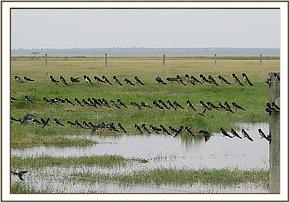MONTHLY REPORT - VETERINARY CLINICAL INTERVENTIONS FOR THE SOUTHERN CONSERVATION AREA (MVU) – FEBRUARY 2016 <<3162016542-pic3
MONTHLY REPORT - VETERINARY CLINICAL INTERVENTIONS FOR THE SOUTHERN CONSERVATION AREA (MVU) – FEBRUARY 2016


The Southern Conservation Area- Mobile Veterinary Unit is grateful to all individuals who played a role in assisting us towards achieving our goal. Many thanks to The David Sheldrick Wildlife Trust, The Samuel J and Ethel Lefrak charitable trust and The Kenya Wildlife Service for their continued support to this unit which aims at immediate response to clinical intervention, wildlife rescues and alleviating wildlife suffering.
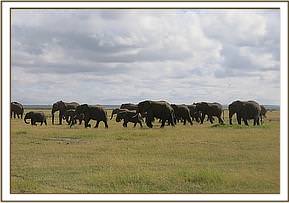

CASE#1 LION POST MORTEM
Date: 6th February 2016
Species: Lion
Sex: Male
Age: Sub- Adult (2 years)
Location: Risa Village, Amboseli Ecoystem
History
This lion was found dead next to a wildebeest carcass near Risa village. The cause of death was unknown, but a spear injury or poison was suspected. A necropsy was preformed and the following were found.
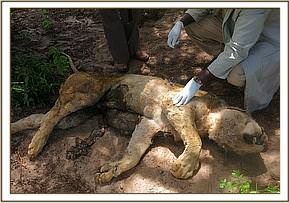

General examination
On examination of the carcass, the following was noted;
- The carcass was in fair body condition with an approximate score of 2.5 in a scale of 1-5, where 1 is poor and 5 is excellent.
- The carcass was fairly fresh and approximately 36hrs post mortem.
- There was an approximately 2 cm x 2cm hole in the right chest wall between the 5th rib spaces. The hole went completely through the chest wall.
- There was a 15cm x 7cm wound extending down into the muscle in the left axilla region. This wound didn’t communicate with the chest cavity.
- Both ears had been severed using a sharp object.
Internal Examination
- Heart: base of the heart had a puncture and contusions surrounding the laceration
- Lungs: The right lung lobes were punctured, hemorrhagic and atelectic
- Stomach: contained remnants of a supposedly wildebeest carcass
Cause of death
Spear wound directly to the heart.
Tentative diagnosis
Traumatic injury of the heart and lungs.
CASE#2 LION RESCUE
Date: 7th February 2016
Species: Lion
Sex: Male
Age: Adult (3 years)
Location: Voi, Tsavo East
History
This lion was found in a 10ft deep hole near the railway construction site in Voi.
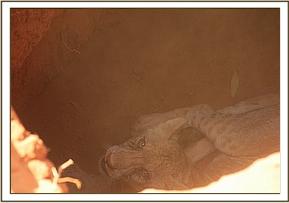
Immobilization, examination and treatment
The lion was immobilized using 4mgs of Medetomidine and 296mg of Ketamine in a 3cc dart using a Dan-Inject dart gun. Full immobilization took place after 10 minutes and a blank dart was shot at him to confirm the lion was fully immobilized before entering the hole. The lion was lifted out with a sling and ropes. The lion was taken back into the bush approximately 1 km from the road and placed under a shady tree. His eyes were lubed with OptiClox but he had not sustained any injuries.


Reversal
After 45 minutes 12mg of Antisedan (Antidote) was administered and he was fully awake after 1 hour.
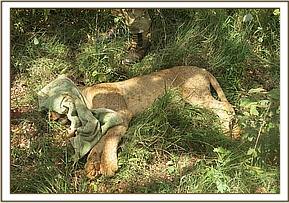
Prognosis
Prognosis is good.
CASE#3 TREATMENT OF INJURED ELEPHANT AT MANYANI
Date: 7th February 2016
Species: Elephant
Sex: Male
Age: Adult (45- 50 years)
Location: Manyani, Tsavo West
History
This adult male elephant was spotted near Manyani Training Department by the DSWT Aerial Unit on the evening of the 6th February 2016. The vet team attended to the case the following day. The male elephant was thought to have a wound to the right flank region and possibly the left shoulder. A decision was made to immobilize and treat the elephant via helicopter due to the terrain.
Immobilization, examination and treatment
The elephant was immobilized using 19mgs Etorphine Hydrochloride in a 3cc dart using Dan-inject system from a helicopter. Full immobilization took place after 4 minutes and he fell into left lateral recumbency. The trunk was maintained patent using a piece of stick placed across the nostril entrances. The ears were used as blindfold. Plenty of water was doused on the ears (pinnae) and the entire body to help cool the elephant during the operation.
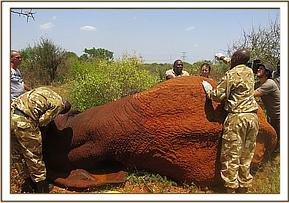

On examination, the elephant had a septic wound to the right flank region. The wound wasn’t deep (aprox. 4 cm) and was walled off via granulation and fibrous tissue. There was a small amount of pus in the wound which is likely an older spear wound that never punctured completely through the abdomen. There were two wounds on the underside of the trunk (6cm x3cm and 8cm x 2cm). Both wounds contained pus but were surrounded by granulation tissue. All wounds were lavaged with water, hydrogen peroxide, and a tincture of Iodine. Topical antibiotic cream, Alum-spray, and green clay were then applied into and around the wound to facilitate healing and avoid infection. All three wounds were healing well as they were closing up via granulation tissue. The elephant was then injected with 200ml Amoxcycillin and 100 ml Dexamethasone HCL at different sites intramuscularly. The entire operation lasted about 40 minutes.
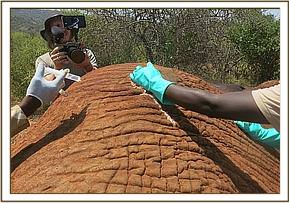

Reversal
Diprenorphine Hydrochloride (60mgs) into the ear vein was used.
Prognosis
Prognosis is good.
